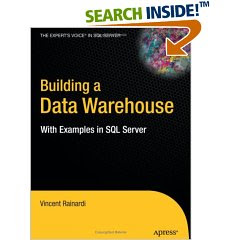
Product Description
Building a Data Warehouse: With Examples in SQL Server describes how to build a data warehouse completely from scratch and shows practical examples on how to do it. Author Vincent Rainardi also describes some practical issues he has experienced that developers are likely to encounter in their first data warehousing project, along with solutions and advice. The RDBMS used in the examples is SQL Server; the version will not be an issue as long as the user has SQL Server 2005 or later.
The book is organized as follows. In the beginning of this book (Chapters 1 through 6), you learn how to build a data warehouse, for example, defining the architecture, understanding the methodology, gathering the requirements, designing the data models, and creating the databases. Then in Chapters 7 through 10, you learn how to populate the data warehouse, for example, extracting from source systems, loading the data stores, maintaining data quality, and utilizing the metadata. After you populate the data warehouse, in Chapters 11 through 15, you explore how to present data to users using reports and multidimensional databases and how to use the data in the data warehouse for business intelligence, customer relationship management, and other purposes. Chapters 16 and 17 wrap up the book: After you have built your data warehouse, before it can be released to production, you need to test it thoroughly. After your application is in production, you need to understand how to administer data warehouse operation.
What you’ll learn
* A detailed understanding of what it takes to build a data warehouse
* The implementation code in SQL Server to build the data warehouse
* Dimensional modeling, data extraction methods, data warehouse loading, populating dimension and fact tables, data quality, data warehouse architecture, and database design
* Practical data warehousing applications such as business intelligence reports, analytics applications, and customer relationship management
Who is this book for?
There are three audiences for the book. The first are the people who implement the data warehouse. This could be considered a field guide for them. The second is database users/admins who want to get a good understanding of what it would take to build a data warehouse. Finally, the third audience is managers who must make decisions about aspects of the data warehousing task before them and use the book to learn about these issues.
DownloadHere



No comments:
Post a Comment